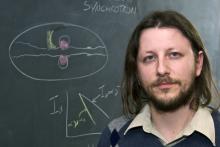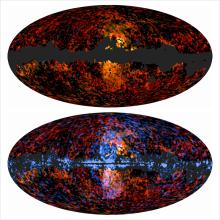
Planck Satellite Reveals Enormous Haze of Energetic Particles at the Center of Milky Way

Images produced by the Planck satellite have revealed an enormous cloud of electrons traveling near the speed of light in the heart of our Galaxy, the Milky Way. These electrons interact with the Galaxy's magnetic field to produce a haze of microwave radiation seen by Planck.
The discovery builds upon earlier research by Planck team member Gregory Dobler, a postdoctoral fellow at the Kavli Institute for Theoretical Physics at UC Santa Barbara. Dobler, along with collaborators, previously studied hints of this emission in images from the Wilkinson Microwave Anisotropy Probe, and led the initial discovery of a gamma-ray counterpart in data from the Fermi Gamma-Ray Space Telescope, originally termed the Fermi "haze" and later the Fermi "bubbles."
The Planck results will be announced this week in Bologna, Italy, at a conference devoted to Planck science. They also will be submitted to the Astronomy and Astrophysics Journal.
Following an orbit that shields the telescope from thermal radiation from both the Sun and the Earth, the Planck satellite is the third major space-based observatory designed specifically to make a full sky map of the Cosmic Microwave Background (CMB) radiation. This CMB is the afterglow of the Big Bang, and provides valuable information about the structures of the Universe. However, in the process, Planck also provides the most detailed view of the Milky Way at microwave wavelengths.
The satellite mission is a joint project between NASA and the European Space Agency. It is a monumental effort by the largest collaboration ever assembled in the field of astronomy, with over 500 team members. In addition to Dobler, UCSB scientists involved in the project include Peter Meinhold, a research physicist; Andrea Zonca, a postdoctoral fellow in the Department of Physics; Jatila van der Veen, outreach coordinator; and Philip Lubin, professor of physics.
Dobler and colleagues at NASA's Jet Propulsion Laboratory (JPL) have used the new Planck data to reveal the mysterious haze with unprecedented clarity.
JPL Planck scientist Davide Pietrobon explains, "The haze comes from the region surrounding the center of our Galaxy and looks like light produced when energetic electrons and positrons accelerate through magnetic fields."
Furthermore, "It is absolutely enormous, with a height of about 35,000 light years in the Planck maps," Dobler said of the haze. What makes this finding particularly compelling, however, is not just the size of the particle cloud, according to JPL Planck scientist Krzysztof Gorski. "We're puzzled, because this haze emission is brighter at shorter wavelengths than similar light emitted elsewhere in the Galaxy," Gorski said.
"This tells us there are more of these very energetic particles at high energies in the haze/bubbles than there are elsewhere in the Galaxy," Dobler said.
And that, he continued, is where the real mystery begins.
According to current understanding, energetic particles (named cosmic-rays) like electrons and positrons are created by explosions of stars called supernovae.
For most of the Galaxy this explanation holds up quite well; however, supernovae simply cannot make enough electrons and positrons at high energy to fill the huge volume occupied by the Planck haze. The question, then, is where these very energetic particles originate.
"There are many possibilities and theories," said Dobler, "ranging from Galactic winds to a jet generated by the black hole at the center of our Galaxy to exotic physics related to dark matter. The problem is that the picture that has emerged with the Planck data, as well as the Fermi data, challenges all of the explanations.
There is no Goldilocks theory yet. None of them fit the data just right."
Additional information is available from the European Space Agency at http://sci.esa.int/science-e/www/object/index.cfm?fobjectid=50004. Dobler's work has also been supported by the Harvey L. Karp Discovery Award.
† Bottom image: Top panel: A full sky view of the Galactic Haze as seen by Planck. The image shows a large haze of microwaves towards the Galactic center indicating a cloud of very energetic particles called electrons and positrons.
These energetic particles interact with the Galactic magnetic field to produce synchrotron radiation seen by Planck. Bottom panel: The same image, but with gamma-ray data from the Fermi Gamma-Ray Space Telescope added in blue. It shows the "Fermi Haze/Bubbles" (Dobler, et al 2010, Su et al 2010), which is a higher energy view of the same structure. The origin of these particles is still unknown, with theoretical ideas ranging from Galactic winds, to jets generated by the Galaxy's central black hole, to dark matter annihilation.
Related Links



